
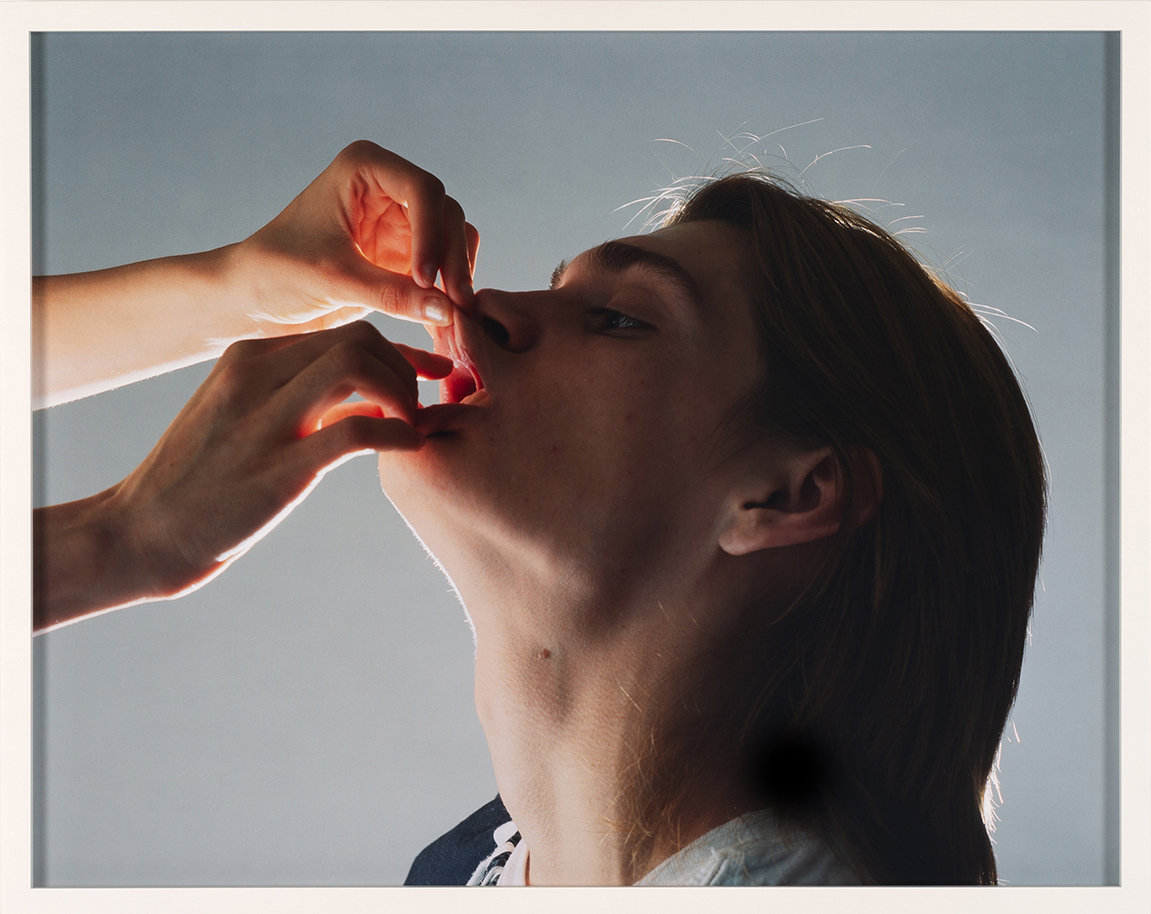
Torbjørn Rødland, Head and Fingers, 2019-2022. Tirage chromogénique sur papier Kodak Endura, 62,5 x 78,5 cm. Edition de 3.
De quoi parle-t-on lorsque l’on parle de #vibes ? Depuis une poignée d’années, le mot a pris un sens spécifique, désignant la texture visuelle, sonore et, en un mot, atmosphérique, telle qu’elle émerge par TikTok pour venir reprogrammer la sphère perceptive tout entière. Désignant l’évidence intuitive, partagée et trans-individuelle d’un certain sentiment flottant, les #vibes, précisément, ne parlent pas : leur qualité est pré-verbale et leur résonnance immédiate. Évoquer l’environnement médiatique, au moment d’aborder le travail de Torbjørn Rødland, est avant tout une manière de retarder l’identification, ou l’assignation à un sujet, une forme, une thématique. Né en 1970 en Norvège et aujourd’hui basé à Los Angeles, l’artiste pratique depuis le milieu des années 1990 une photographie analogique, dont la genèse est tout aussi construite et mise en scène que la réception est poétique et subjective. Procédant par synthèse de réalités disjointes, celui qui aime à se définir comme faiseur d’images organise une lente remontée de ressentis archaïques, immémoriaux ou tout simplement paradoxaux.
En cela, le tournant affectif actuel, il le complexifie, l’extirpe de ses manifestations de surface pour nous le présenter à peine transi. A même la mécanique post-capitaliste léchée, quelque chose alors se grippe. L’attention, cette ressource raréfiée, reste ici accrochée, prise dans les rets d’alliances fortuites quasi-surréalistes. A la galerie Air de Paris, Theatre of Immediacy [théâtre de l’immédiateté], décline autant d’itérations récentes de ces mariages contre-nature et néanmoins déjà consommés, maintenus dans l’implacable indécision entre mélancolie et malaise, élégie et étrangeté, attraction et angoisse. Une première série de six photographies, unie par une même teinte orangée rétroéclairée, prête une allégeance de surface aux genres photographiques : natures mortes, portraits et scènes de genre. Ici cependant, ce seront des solides pyramidesques criblés de trous – matérialisation de l’emoji *fromage* ? – venus choir mollement au milieu d’un parterre de lierre (Early Evening Cheese Heads, 2022). Un buste féminin vêtu d’un chemisier aérien dont la main gantée d’acier vient nonchalamment enserrer une épée médiévale (Sword and Glove, 2022). Ou encore, un lapin aux longues oreilles emmailloté dans un t-shirt filet et passé entre deux mains comme le témoin d’une course relai (Shared Rabbit, 2021).
Pour Torbjørn Rødland, les associations ne sont jamais aléatoires et se doivent de faire sens. Elles ne sont pas pour autant élucidables ou déchiffrables, au sens où il n’y a pas de rébus ou de clef. Tout se joue dans ce qui partout affleure, et ce-faisant demeure, toujours et malgré tout polysémique. Or plus qu’à toute autre époque peut-être, l’attention au sensible est à fabriquer. Dressée contre le sémiocapitalisme, elle est à conquérir à rebours de ses procédés d’asservissement collectifs tout autant qu’à ses corrélats intériorisés de fabulations paranoïaques ou de conspirationnistes. L’exposition présente enfin deux vidéos récentes. Extension de l’image fixe selon d’autres paramètres, l’artiste initie cette partie de sa pratique en 2004, soit un an avant l’arrivée de Youtube. S’il tire son rythme et son montage de la télévision et des anime, il anticipe intuitivement ici aussi certaines caractéristiques, culturelles plutôt que techniques, de l’écosystème digital -- GIFs et clips destinés au partage en réseau.
Visionnées ensemble, Between Fork and Ladder (2018) et Elegy for the Silent (2020) amènent la possibilité d’une lecture plus immédiatement politique, une piste parmi d’autres que l’artiste se garde d’élire sans pour autant l’exclure. Dans la première, un garçonnet découpe, l’air absent, les motifs d’un pyjama à l’effigie d’une figurine de cartoon. Il s’agit de Pepe the Frog, devenu tristement célèbre sous la recontextualisation d’un mème, dont l’usage, transitant par les bas-fonds du forum 4chan, crèvera la surface médiatique pour mieux asseoir l’avènement de l’Alt Right. La seconde, elle, place au centre un homme âgé, tout aussi las, placé face à ses aspirations disqualifiées.
Deux générations sont présentées en pendant. Elles sont blanches, mâles et privilégiées, et peut-être aussi toutes deux sacrifiées. Ce sont des portraits individualisés mais qui déjà sont jetés, par la présentation à d’autres, dans l’ambiguïté de la vie en société. Il n’y a pas de script ni de narration, seulement une décélération doublée d’une densification de ce qui est là, évolue dans une lumière changeante, et récuse l’éternel retour du même. Obstinément, âprement, les images fixes et mouvantes de Torbjørn Rødland prennent sans ironie le parti de la complexité, maintenue au sein même de la logique algorithmique et la perte de sens.
Ingrid Luquet-Gad
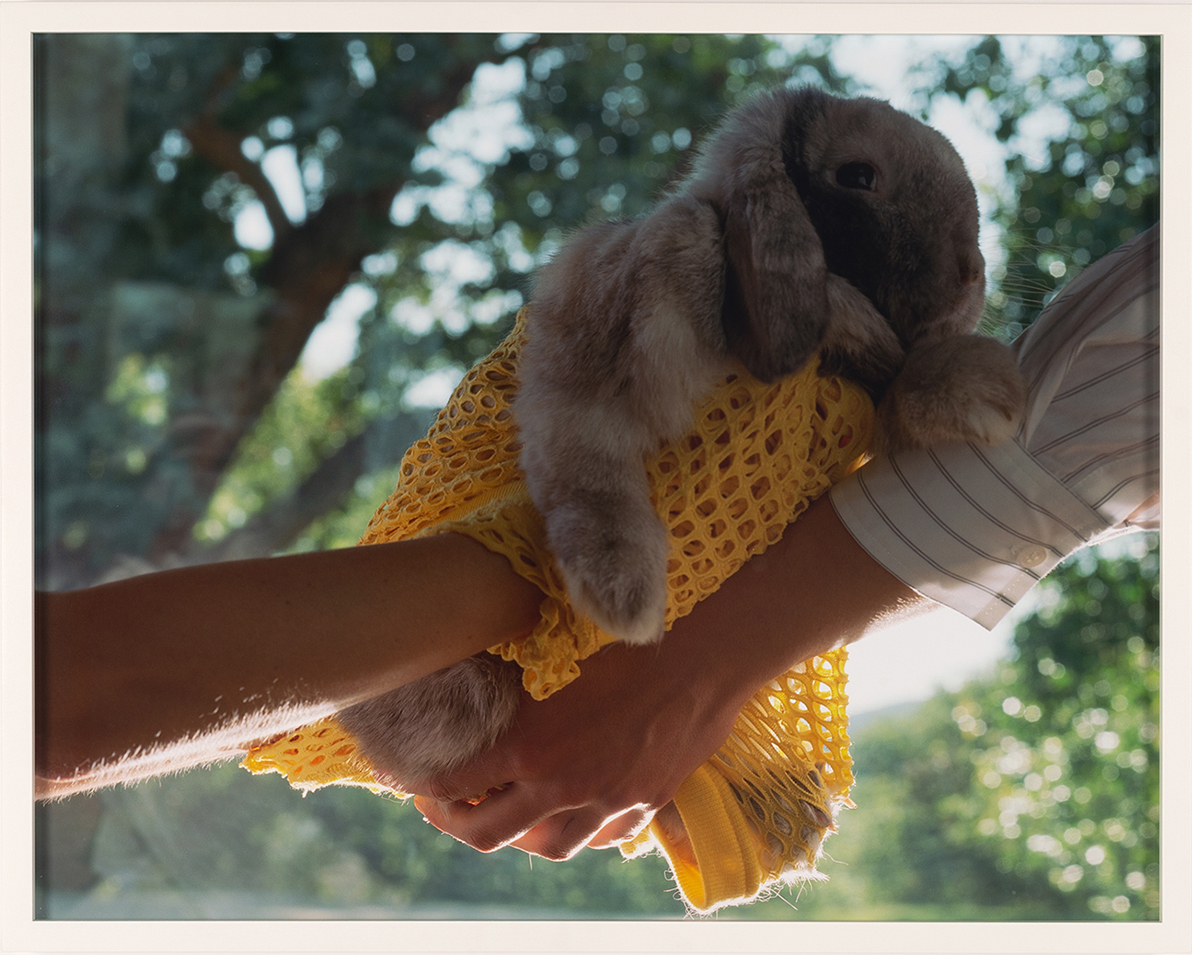
Torbjørn Rødland, Shared Rabbit, 2021. Tirage chromogénique sur papier Kodak Endura, 62,5 x 78,5 cm. Edition de 3.
What do we mean when we speak of #vibes? Over the last few years, the expression has taken on a particular meaning, referring to the kind of visual, audio and (in a word) atmospheric textures coming out of TikTok and reprogramming the entire perceptual realm. Used to indicate the intuitive, shared and trans-individual patency of a certain floating feeling, #vibes do not exactly speak: they have a pre-verbal quality and their resonance is immediate. Alluding to the media environment when approaching the work of Torbjørn Rødland is primarily a way of postponing the moment of identifying or assigning a subject, form or theme to it. Born in 1970 in Norway and now based in Los Angeles, the artist has been practising analogue photography since the mid-1990s: while the creation of this work relies on construct and staging, its reception is poetic and subjective. Rødland likes to define himself as an image-maker and his synthesis of disjunct realities slowly mounts to produce feelings that are archaic, immemorial or simply paradoxical.
In this way, he adds complexity to the modern-day affective turn, dissociating it from its superficial expressions to present it to us barely transfixed. Something seizes up right there in the frictionless post-capitalist mechanism. That rarefied resource attention is left hanging, caught in the snare of fortuitous, quasi-surrealist alliances. At Air de Paris, Theatre of Immediacy offers a range of recent iterations of these unnatural, yet already consummated unions, maintained in a state of relentless vacillation between melancholy and disquiet, elegy and incongruity, attraction and anguish.
The first series of six photographs, unified by the same backlit orangey tint, has a superficial allegiance to photographic genres: still lifes, portraits and genre scenes. Here, however, we are confronted with pyramidal solids riddled with holes – a material expression of the ‘cheese’ emoji? – that have fallen gently into a bed of ivy (Early Evening Cheese Heads, 2022); a female bust dressed in a light blouse casually clutching a medieval sword in her steel gauntlet (Sword and Glove, 2022); and a long-eared rabbit wrapped in a net t-shirt being passed from hand to hand like the baton in a relay race (Shared Rabbit, 2021).Rødland’s associations are never adventitious – they need to make sense for him. However, they cannot be ‘solved’ or deciphered, inasmuch as there is no rebus or key. Everything remains polysemous, now, always and in spite of everything. Today especially, perhaps more than in any other era, attention to the manifest must be produced. As a bulwark against semiocapitalism, attention should be recaptured by going against the processes of collective enslavement and the internalised correlates of paranoid fantasies and conspiracy theories.
The exhibition presents two recent videos. Extending the still image through different parameters, the artist embarked on this phase of his practice in 2004, a year, that is, before the advent of YouTube. While his rhythm and editing approach are drawn from television and anime, he also intuitively anticipates – at the cultural rather than the technical level – certain characteristics of the digital ecosystem: GIFs and clips intended for networked sharing. Between Fork and Ladder (2018) and Elegy for the Silent (2020) introduce the possibility of a more directly political reading, one of several options that the artist refrains from settling upon yet does not exclude. In the first, a young boy absent-mindedly cuts out the motifs from a pair of cartoon-character pyjamas. The image is of Pepe the Frog, who became infamous by being recontextualised as a meme that was routed through the murky depths of the 4chan forum and broke the surface as a media phenomenon that helped establish the emerging alt-right. The second work, meanwhile, focuses on a worn-out man acknowledging that his dreams have lost credibility.
Two generations are presented as counterparts. They are white, male and privileged – and perhaps both have been sacrificed. They are individualised portraits, yet their presentation in relation to other images puts them in the midst of the ambiguities of life in society. There is no script or narrative, just a deceleration coupled with a densification of what is given, evolving in a changing light and rejecting the eternal return of the same. Torbjørn Rødland’s still and moving images side with complexity – obstinately, harshly and without irony – a complexity maintained at the very heart of the algorithmic logic and the loss of meaning.
Ingrid Luquet-Gad
(Translated by Simon Cowper)
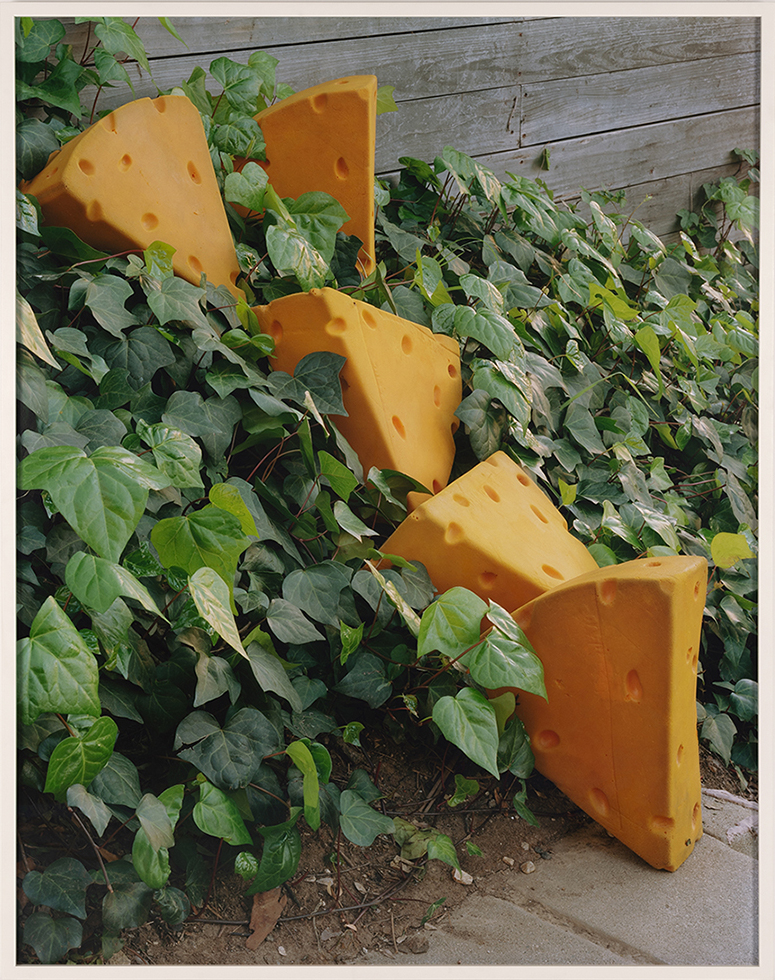
Torbjørn Rødland, Early Evening Cheese Heads, 2022. Tirage chromogénique sur papier Kodak Endura, 142,5 x 112,5 cm. Edition de 3.
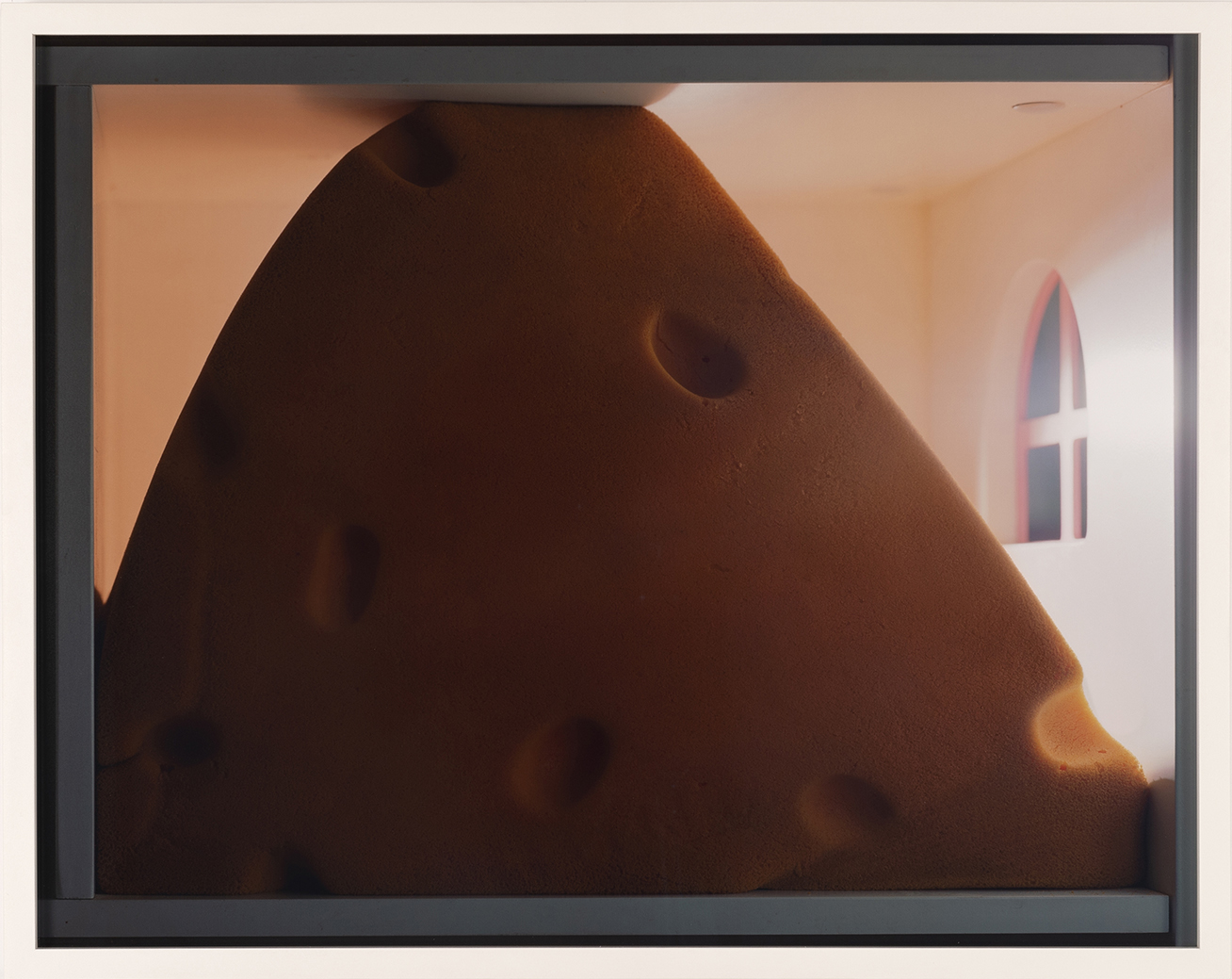
Torbjørn Rødland, Tight, 2022. Tirage chromogénique sur papier Kodak Endura, 62,5 x 78,5 cm. Edition de 3.

Torbjørn Rødland, Sword and Glove, 2022. Tirage chromogénique sur papier Kodak Endura, 76 x 62,5 cm. Edition de 3.
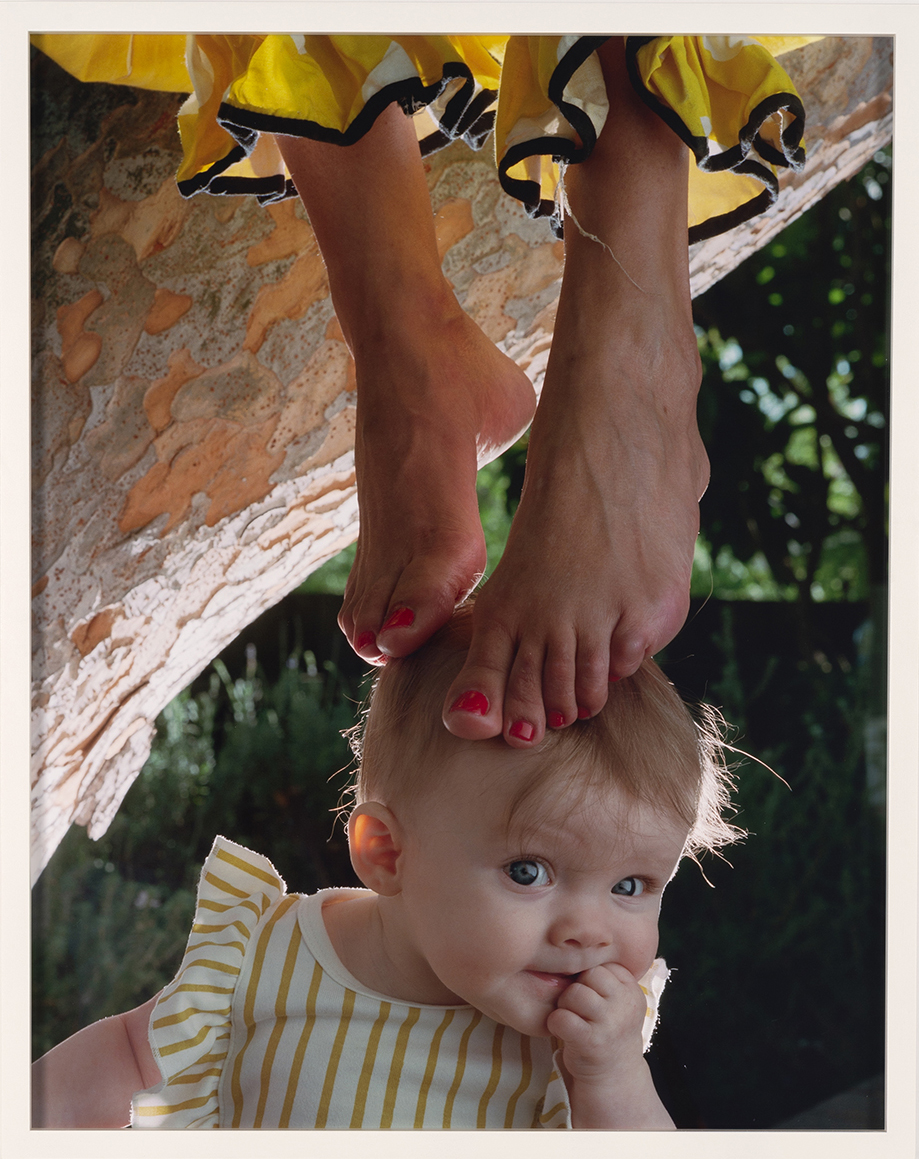
Torbjørn Rødland, Spiritello, 2022. Tirage chromogénique sur papier Kodak Endura, 78,5 x 62,5 cm. Edition de 3.